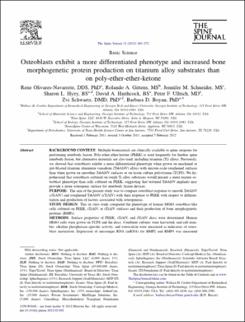Osteoblasts exhibit a more differentiated phenotype and increased bone morphogenetic protein production on titanium alloy substrates than on poly-ether-ether-ketone
Date
2012-01-12Author
Olivares-Navarrete, Rene
PhD, DDS
Gittens, Rolando A.
MS
Schneider, Jennifer M.
MS
Hyzy, Sharon L.
BS
Haithcock, David A.
Ullrich, Peter F. MD
Schwartz, Zvi
Boyan, Barbara D.
Metadata
Show full item recordAbstract
Multiple biomaterials are clinically available to spine surgeons for performing interbody fusion. Poly-ether-ether-ketone (PEEK) is used frequently for lumbar spine interbody fusion, but alternative materials are also used, including titanium (Ti) alloys. Previously, we showed that osteoblasts exhibit a more differentiated phenotype when grown on machined or grit-blasted titanium aluminum vanadium (Ti6Al4V) alloys with micron-scale roughened surfaces than when grown on smoother Ti6Al4V surfaces or on tissue culture polystyrene (TCPS). We hypothesized that osteoblasts cultured on rough Ti alloy substrates would present a more mature osteoblast phenotype than cells cultured on PEEK, suggesting that textured Ti6Al4V implants may provide a more osteogenic surface for interbody fusion devices. PURPOSE: The aim of the present study was to compare osteoblast response to smooth Ti6Al4V (sTiAlV) and roughened Ti6Al4V (rTiAlV) with their response to PEEK with respect to differentiation and production of factors associated with osteogenesis. STUDY DESIGN: This in vitro study compared the phenotype of human MG63 osteoblast-like cells cultured on PEEK, sTiAlV, or rTiAlV surfaces and their production of bone morphogenetic proteins (BMPs). METHODS: Surface properties of PEEK, sTiAlV, and rTiAlV discs were determined. Human MG63 cells were grown on TCPS and the discs. Confluent cultures were harvested, and cell number, alkaline phosphatase–specific activity, and osteocalcin were measured as indicators of osteoblast maturation. Expression of messenger RNA (mRNA) for BMP2 and BMP4 was measured

